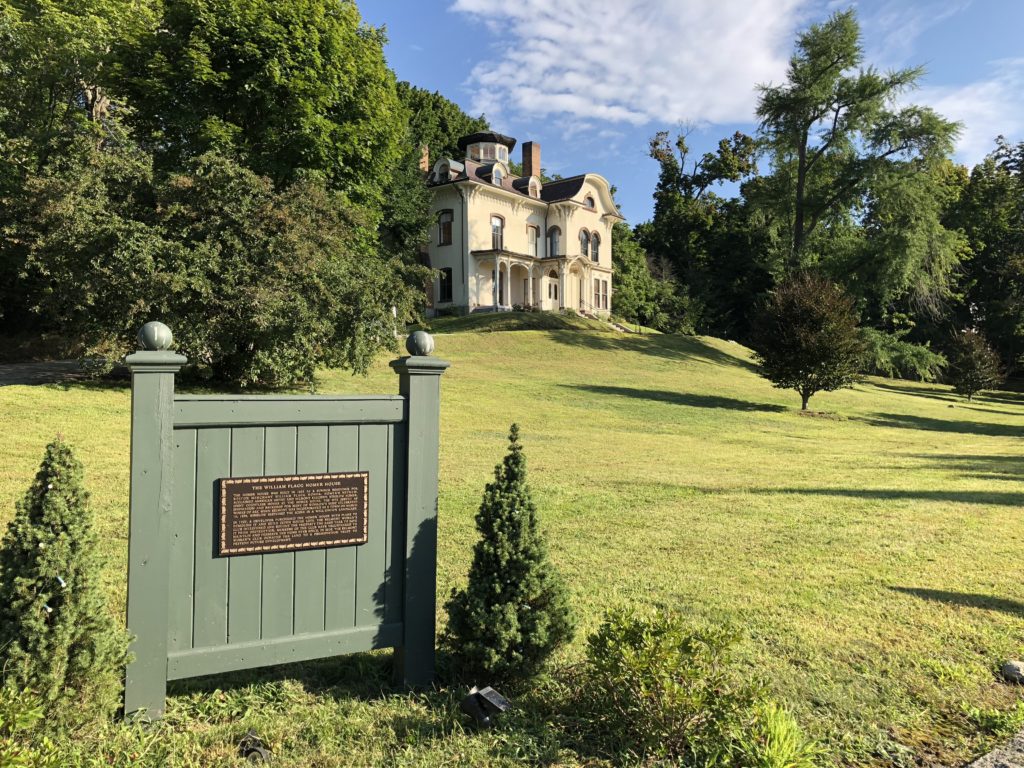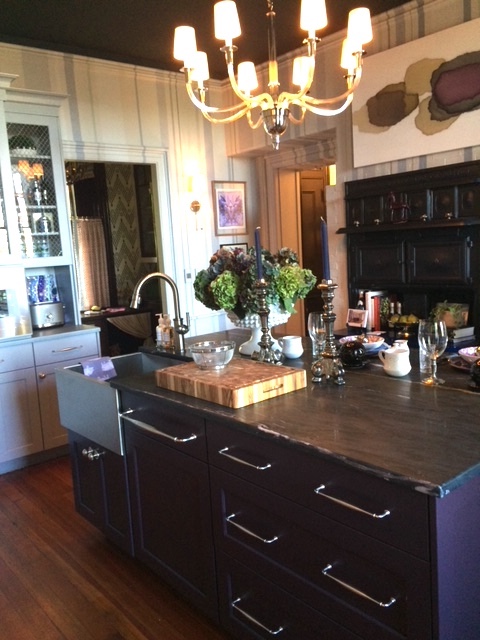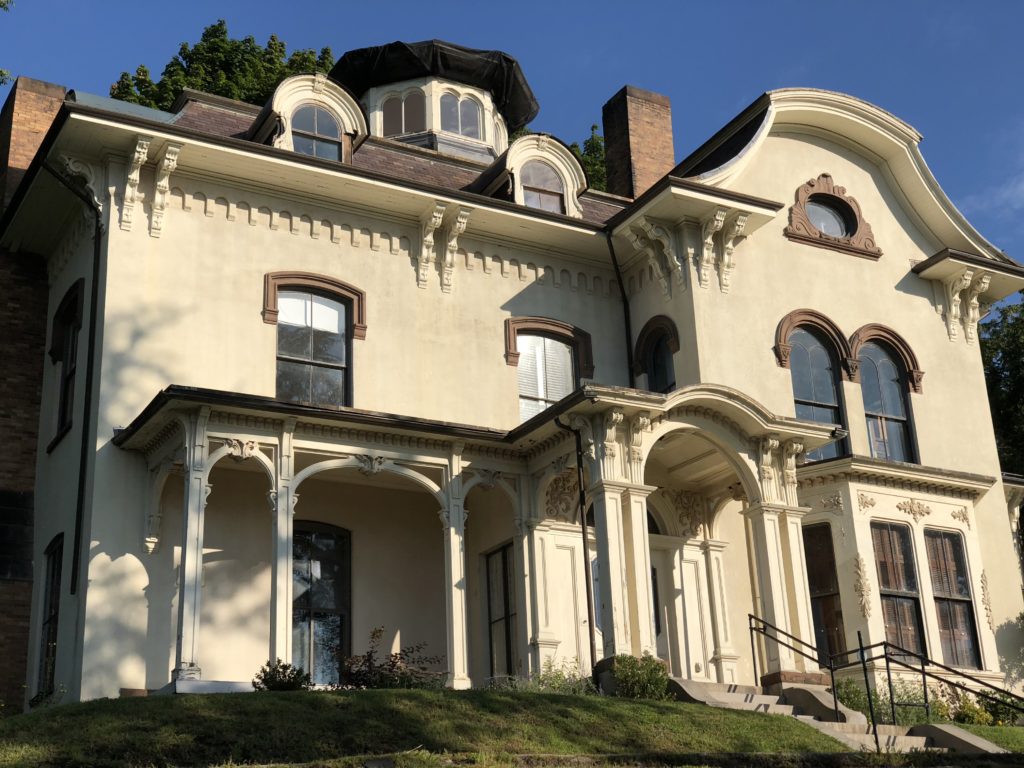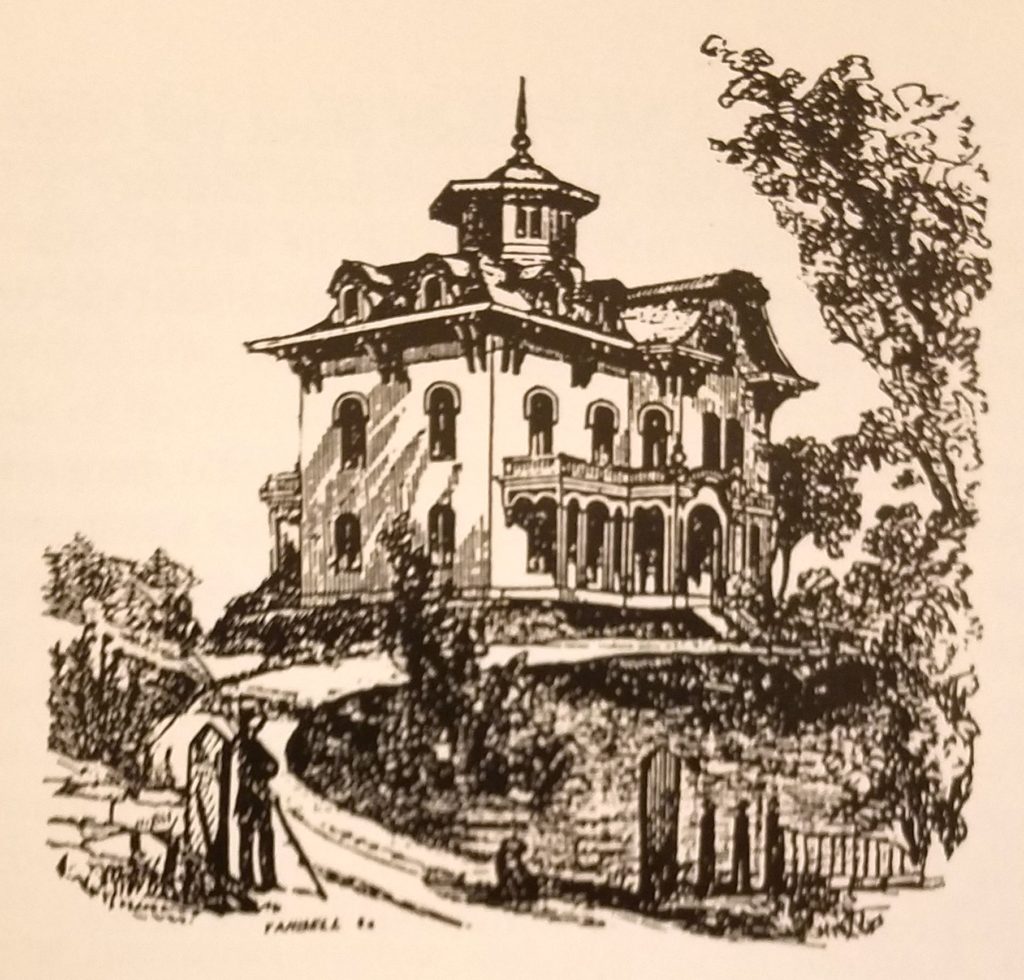By Wendy Murphy
The Belmont Woman’s Club has been working on many projects at the beautiful William Flagg Homer House. Located at 661 Pleasant Street, across from Town Hall in the Pleasant Street Historic District, the Homer House is named for its original owner, William Flagg Homer, a wealthy Boston merchant who built the property in 1853 as a summer residence. William Flagg was uncle to famed American artist Winslow Homer, whose artwork features numerous scenes of Belmont people and places, including his uncle’s home.

The house in August 2018, with cupola restoration nearing completion and the recent addition of a bronze plaque at the intersection of Concord Avenue and Pleasant Street. (Sara McCabe photo)
The Homer House has been actively undergoing restoration since 2016, when the Woman’s Club won a Community Preservation Act grant to restore the third-floor cupola. The crowning glory of the house boasts 360-degree views that reach to Boston and beyond.
Restoration of the cupola will be completed in fall 2018 and will involve replacing its roof, repairing windows and woodwork, painting, and installing a finial on top. Contractor Marshall White and architect Gary Wolf have worked with the Woman’s Club, town officials, and Belmont’s Historic District Commission to select historically appropriate materials, designs, and paint colors.
In addition to the cupola project, the Homer House has undergone extensive interior renovations, thanks to the Junior League of Boston, which selected the home as its 2017 Designer Show House. The Junior League set up residence for nine months and contracted with more than a dozen designers, who redesigned each room to their taste. The public was invited to tour the redesigned interiors, buy show items, and hire the designers for their own projects. The Show House upgrades vastly improved the condition of the home’s interior at little cost to the Woman’s Club. All the rooms have fresh paint, and many have luxurious window treatments. The Junior League also brought an expert to Belmont to repair and restore the lincrusta wallcovering in the library, and paid nearly all expenses. (Lincrusta is a thick, deeply embossed wallcovering introduced in 1877 and made of gelled linseed oil, wood flour, and paper. Because the linseed gel continues to dry and toughen over time, lincrusta is very durable, and examples in many historic buildings have lasted for more than a century.)
The Homer House gained a modern new kitchen from the Junior League investment as well, enhancing its desirability as a rental property. With state-of-the-art appliances and a center island, the space is far more conducive to catering for large parties, weddings, and other occasions. Rental fees from such events are a significant source of funding to the Woman’s Club for building repairs and maintenance. Further increasing rental value is a handicapped-accessible bathroom installed in 2018.

As the 2017 Junior League of Boston Designer Show House, the Homer House benefited from many upgrades, including a modern kitchen, which has helped increase rental value. (Belmont Woman’s Club photo)
The interwoven histories of the house, the Woman’s Club, and the Homer family are now honored on a new bronze plaque at the intersection of Concord Avenue and Pleasant Street. Affixed to a small fence piece adjacent to the sidewalk, the plaque describes the 19th-century relationship of the house to Winslow Homer’s art, explains that the Woman’s Club saved the house from destruction in 1927, and notes that the Club donated the land to a public trust in 2010 to prevent future development. A wooden sign on the Pleasant Street side was also recently repainted for better visibility.
The Woman’s Club is planning to file another Community Preservation Act grant application next year to fund window repairs. With virtually every window in the Homer House coming apart from its frame, and an estimate of $2,000 to restore each of more than two dozen windows, the expense will be significant.
In an effort to raise public awareness about the Homer House and its need for financial support from the public, the Woman’s Club obtained funds to create a short film explaining the relationship between the Homer House, the town of Belmont, and Winslow Homer’s art. The film, entitled Winslow Homer’s Belmont, was completed in 2017 and can be viewed at belmontmedia.org, the Belmont Media website.
Few people are aware that Winslow Homer lived in Belmont, much less that many of his works depict Belmont people and places. The history books describe Winslow Homer as being born in Boston, and later moving to Cambridge, which is technically correct, but the part of Cambridge where Homer lived as a young man became the town of Belmont while he was living there. Indeed, Homer drew a landscape on the day Belmont was incorporated as a town, in 1859, and entitled it “The New Town of Belmont.” Though he later moved to New York, his parents continued to live in Belmont, not far from the Homer House.

Restoration of the third-floor cupola will include a finial on top, as seen in the historic drawing below. (Sara McCabe photo; Illustration courtesy of the Belmont Historical Society)

The history of the Homer House property dates back far before the current 1853 building. The land was first owned by Belmont’s founder, Roger Wellington, in 1636. The Wellingtons passed it down for generations within their family until 1826, when Jeduthan Wellington sold it for $400 to his son-in-law, Samuel O. Mead. Mead and his wife, Mary Maria, built a federal colonial style house on the land. Years later they sold it for $5,000 to William Flagg Homer, who was married to Mary Maria’s sister, Adeline Wellington. Selling the property to the husbands of Jeduthan’s daughters was a way of keeping the land in the Wellington family, at a time when women could not legally own property.
Mead’s colonial style home was later moved to 504 Concord Avenue, and the Homer House was built in its place as a summer residence, in 1853. William Flagg Homer eventually lived in the house full time until his death in 1883, after which the property was sold for the first time outside of the Wellington family, to neighbor Susan Blake, who lived across the street, for $21,000. (By 1844, women could possess property in Massachusetts.) Blake expanded the library and added etched glass to the front doors.
In 1927, a developer had plans to tear the house down and build seven lots on the land. The Belmont Woman’s Club rallied to save the Homer House from destruction. They paid a $5,000 deposit, obtained two mortgages, and purchased the Homer House for $25,000. They replaced the gas lighting with electricity and began hosting lectures and community events in their new home. A 501(c)(3) charitable organization, the Woman’s Club has volunteered ever since to preserve and maintain the Homer House for future generations.
Wendy Murphy is co-president of the Belmont Woman’s Club and adjunct professor of sexual violence law at New England Law|Boston, where she has taught for 15 years.


Sorry, the comment form is closed at this time.